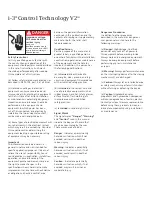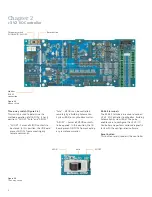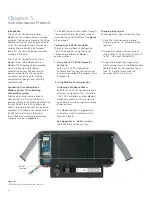
Safety Precautions
(a) Only qualified persons familiar with
the construction and operation of this
equipment should perform work described
in this set of instructions. Such work
should be performed only after reading
this complete set of instructions.
(b) Follow safety related work practices, as
described in NFPA 70E, part II, at all times.
(c) Hazardous voltages in electrical
equipment can cause severe personal
injury or death. Energizing this equipment
for the first time after initial installation
or maintenance is potentially dangerous.
Inspection and maintenance should be
performed on this equipment and
equipment to which power has been
cut off, disconnected, and electrically
isolated so that no accidental contact
can be made with energized parts.
(d) Some types of electrical equipment will
cause harmonics in the electrical system
which may result in overheating. Consider
this condition when determining this
equipment loading, as possible de-rating
of equipment may be necessary.
Important
The information contained herein is
general in nature and not intended for
specific application purposes. It does not
relieve the user of responsibility to use
sound practices in application, installation,
operation, and maintenance of the
equipment purchased. Siemens reserves
the right to make changes in the
specifications shown herein or to make
improvements at any time without notice
or obligations. Should a conflict arise
between the general information
contained in this publication and the
contents of drawings or supplementary
material or both, the latter shall
take precedence.
Qualified Person
For the purpose of this manual and
product labels, a qualified person is
one who is familiar with the installation,
construction, operation or maintenance
of the equipment and the hazards
involved. In addition, this person has
the following qualifications:
(a)
is trained
and authorized to
de-energize, clear, ground, and tag
circuits and equipment in accordance
with established safety practices.
(b)
is trained
in the correct care and
use of protective equipment such as
rubber gloves, hard hat, safety glasses
or face shields, flash clothing, etc.,
in accordance with established
safety practices.
(c)
is trained
in rendering first aid.
Signal Words
The signal words
“Danger,” “Warning”
and
“Caution”
used in this manual
indicate the degree of hazard that
may be encountered by the user.
These words are defined as:
Danger
- Indicates an imminently
hazardous situation which if not
avoided, will result in death or
serious injury.
Warning
- Indicates a potentially
hazardous situation which, if not
avoided, could result in death or
serious injury.
Caution
- Indicates a potentially
hazardous situation which, if not
avoided, may result in minor or
moderate injury.
Dangerous Procedures
In addition to other procedures
described in this manual as dangerous,
user personnel must adhere to the
following warnings:
(a)
Danger!
High Voltage. Qualified
personnel only. Lock off all power to
this equipment before working inside.
Always work on de-energized equipment.
Always de-energize equipment before
performing any tests, maintenance
or repair.
(b)
Warning!
Always perform maintenance
on the interrupting device after the closing
mechanism(s) are discharged.
(c)
Caution!
Always let an interlock device
or safety mechanism perform its function
without forcing or defeating the device.
(d)
Caution!
Hydrocarbon spray
propellants and hydrocarbon compounds
will cause degradation of certain plastics.
Contact your local Siemens representative
before using these products to clean or
lubricate components during installation
or maintenance.
i-3
®
Control Technology V2
TM
DANGER
Hazardous voltage.
Will cause death or
serious injury.
Keep out.
Qualifi ed personnel only.
Disconnect and lock off all
power before working on
this equipment.
Summary of Contents for i-3
Page 1: ...3 User Guide www usa siemens com i 3 i 3 V2 I O Controller Modbus ...
Page 54: ...52 Appendix E USB to RS485 Converter Driver Software Installation Instructions ...
Page 57: ...55 Appendix F Recommended Input Devices ...
Page 58: ...56 Appendix F Recommended Input Devices ...
Page 59: ...57 Appendix F Recommended Input Devices ...
Page 60: ...58 Appendix F Recommended Input Devices ...
Page 61: ...59 Appendix F Recommended Input Devices ...
Page 62: ...60 Appendix F Recommended Input Devices ...
Page 63: ...61 Appendix F Recommended Input Devices ...
Page 64: ...62 Appendix F Recommended Input Devices ...
Page 65: ...63 Appendix F Recommended Input Devices ...
Page 66: ...64 Appendix F Recommended Input Devices ...
Page 67: ...65 Appendix F Recommended Input Devices ...
Page 68: ...66 Appendix F Recommended Input Devices ...
Page 69: ...67 Appendix F Recommended Input Devices ...
Page 70: ...68 Appendix F Recommended Input Devices ...
Page 71: ...69 Appendix F Recommended Input Devices ...
Page 72: ...70 Appendix F Recommended Input Devices ...
Page 73: ...71 Appendix F Recommended Input Devices ...
Page 74: ...72 Appendix F Recommended Input Devices ...
Page 75: ...73 Appendix G Common Networking Setups ...
Page 76: ...74 Appendix G Common Networking Setups ...
Page 78: ...76 Notes ...
Page 79: ......



































